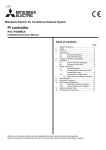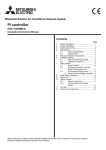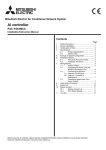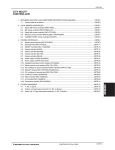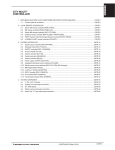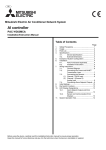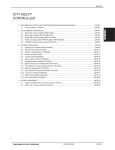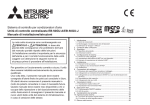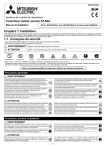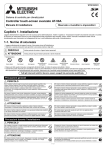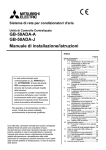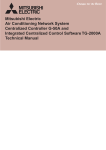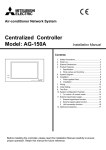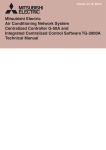Download Mitsubishi Electric PAC-YG66DCA Instruction manual
Transcript
GB Mitsubishi Electric Air Conditioner Network System DIDO controller PAC-YG66DCA Installation/Instruction Manual Table of Contents Page 1. 2. 3. 4. 5. 6. 7. 8. 9. 10. 11. Safety Precautions ..............................................1 Usage ..................................................................2 Parts List..............................................................2 Specifications ......................................................3 4-1. Device Specifications .........................3 4-2. External Dimensions...........................4 Example of System Configuration .......................4 Installation ...........................................................5 6-1. Parts Purchased Separately...............5 6-2. Installation Instructions .......................6 Wiring Instructions ...............................................7 7-1. Terminal Diagram ...............................7 7-2. Connecting the Power and M-NET Transmission Lines.............................8 7-3. Connecting the Signal Lines...............8 7-3-1. Standard Terminals (Channels 1 and 2) .............................9 (1) Inputs..................................................9 (a) Non-voltage a-contact Inputs ........9 (2) Outputs ...............................................9 (a) Non-voltage Relay Contact Outputs ............................9 (b) Transistor Outputs (Open Collector)..........................10 7-3-2. Expansion Connectors (Channels 3 to 6) ..............................11 (1) Expansion Inputs/Outputs ................11 Initial Settings ....................................................12 Dip Switch Functions .........................................13 LED Display Designations .................................14 10-1. Operation Status Displays ................14 10-2. Communication Error Displays .........15 System Operation Test......................................16 Before using the device, carefully read this installation/instruction manual to ensure proper operation. Keep this manual for future reference and give it to the technician when the device is reinstalled or repaired. 1 Safety Precautions • Thoroughly read the following safety precautions before use. • Hazards that can occur from incorrect handling are classified by the symbols below: Warning Incorrect handling can result in death, serious injury, etc. Caution Incorrect handling can result in bodily injury and/or structure damage. • After reading this manual, keep this manual for future reference. When the device is reinstalled or repaired, give this manual to those who provide these services. When the user changes, make sure that the new user receives this manual. WARNING Only a dealer or qualified technician should install, relocate, reinstall, or repair the device. Improper installation or repair may result in electrical shock or fire. Do not make any modifications or alternations to the device. Modifications or improper repair may result in electric shock or fire. Consult your dealer for repair. Properly install the device on a stable, load-bearing surface. Device installed on an unstable surface may fall and cause injury. All electrical work should be performed by an authorized electrician according to local regulations and instructions outlined in this manual. Capacity shortage to the power supply circuit or improper installation may result in electrical shock or fire. Only use the specified cables; securely connect each so that the terminals do not bear any cable weight. Improperly connected or short-circuited cables may produce heat and cause a fire. Properly install the device according to the instructions in this Installation/Instruction Manual. Improper installation may result in electric shock or fire. CAUTION Do not install the device in a location where a flammable gas leak may occur. Gas may leak, collect around the device, ignite, and/or explode. Do not install the device in a bathroom, kitchen, or any room where steam could form. Condensation may develop and cause electrical shock and/or the device to malfunction. Do not install the device in environments where large amounts of oil (including machine), sulfidizing gas, or acidic, alkaline, chemical sprays are present. These types of substances may damage internal parts, cause device performance to be reduced, and cause electrical shock. Use standard wires with the proper current capacity to avoid the possibility of current leak, excessive heat, and/or fire. Do not touch the main circuit board; also, make sure that dust does not accumulate on the circuit board. When installing the device in a hospital, communication facilities, etc., provide sufficient protection against frequency noise. Power generators and inverters, high-frequency medical, or radio communication equipment may interfere with the normal operation of this device. Subsequently, the device may also affect medical treatment, image broadcasting, etc., by creating frequency noise. Include some slack in the power supply wires. Tension on the wires may cause them to excessively heat up and/or break, resulting in a fire. Do not immerse the device in water. Doing so may lead to electric shock or malfunctions. The maximum applied voltage for the device is 24 VDC - do not use with an AC power source. (The maximum applied voltage for the M-NET terminal is 30 VDC.) Using the incorrect voltage may result in device failure, ignition, and/ or fire. Do not install the device in a location where there is direct sunlight or where the temperature may become greater than 40°C (104°F) or less than 0°C (32°F). If the device is installed in such place, it may result in deformation or malfunctions. 1 2 Usage The DIDO controller is used in combination with the AG-150A or G(B)-50A to operate general-purpose equipment, as well as to monitor operating and error status. It is equipped with two sets of standard terminals (Channels 1 and 2), and four sets of expansion connectors for the input/output terminals. Expansion cable is optional. Other devices can only be controlled from AG-150A LCD, AG-150A Web browser, G(B)-50A Web browser and TG2000A. Operation cannot be monitored or performed from the G-50A LCD. In addition, this device includes a function that interlocks M-NET devices such as indoor units, LOSSNAY, general equipment, etc. Please refer to the operating manual for the Maintenance Tool for details on interlock settings. Caution: Usage Restrictions • Mitsubishi Electric does not take financial responsibility for damages caused by issues beyond our control or special circumstances (predicable or unpredictable); and secondary or accidental damages, and damages to other objects. We also do not take financial responsibility for opportunities lost as a result of device failure, or electrical power failure at the enduser site. Mitsubishi Electric does not take financial responsibility caused by end-users' requests including, but not limited to, device testing, startup, readjustment, and replacement. • Do not use this device in disaster prevention, security, or "critical to life" applications. • It is recommended to provide an external switch for general-purpose equipment in case of a failure of the DIDO controller or a peripheral part. 3 Parts List The following parts should be included in your shipment: Number Part Name Quantity 1 DIDO controller 1 2 Installation/instruction manual (this document) 1 * In addition to the parts listed above, see your local Mitsubishi Electric dealer to purchase the other parts necessary to operate this device (Refer to section 6-1). Furthermore, depending on the application, other Mitsubishi Electric parts may be required. For details, refer to "6. Installation". 2 4 Specifications 4-1. Device Specifications Item Power Supply Rating and Specification Screw terminal block (M3) (*9) 24 VDC±10%: 5 W (*1) M-NET communication Standard ON/OFF, (ON) (*4) (OFF) (*4) Interface Expansion Output Screw terminal block (M3) (*9) Applied load MAX: 24 VDC, 5 W Non-voltage Relay contact (2) MIN: 5 VDC, 2 mW * AC loads cannot be connected. Screw terminal block (M3.5) (*9) 24 VDC 40 mA or less (*5) Transistor (2) Output (*3) Input 17 to 30 VDC (*2) Applied load MAX: 24 VDC, 5 W Non-voltage Relay contact (2) MIN: 5 VDC, 2 mW * AC loads cannot be connected. Screw terminal block (M3.5) (*9) Transistor (2) 24 VDC 40 mA or less (*5) Screwless terminal block Error/Normal Non-voltage a contact (2 each) 24 VDC 1 mA or less (*6) Screwless terminal block ON/OFF, (ON) (*4) Transistor (4 each) 24 VDC 40 mA or less (*5) 9 pin connector 24 VDC input (4 each) 24 VDC 1 mA or less (*7) 9 pin connector ON/OFF (OFF) (*4) Input Screwless terminal block ON/OFF Error/Normal Output Pulse Width 1s ± 30 ms 1s ± 30 ms Interlock Function Interlock M-NET devices and output contacts according to status of input contacts. (*8) Environment Conditions Temperature Dimensions 200 (W) × 120 (H) × 45 (D) mm / 77/8 (W) × 43/4 (H) × 125/32 (D) in Weight 0.6 kg / 13/8 lb Time Backup During Power Failure In the event of power failure or shut-off, the internal capacitor will continue to track time for approximately one week. (The internal capacitor takes about 24 hours to fully charge; a replacement battery is not necessary.) Installation Environment Inside the metal control panel (indoors) * Use this product in a hotel, a business office environment or similar environment. Humidity Operating temperature range 0 to 40°C [32°F to 104°F] Storage temperature range -20 to 60°C [-4°F to 140°F] 30 to 90%RH (no condensation) *1: For details, refer to "6-1. Parts Purchased Separately". *2: Supply electric power from a power unit for the transmission line or an outdoor unit. Furthermore, the power consumption factor of the M-NET circuitry of this device is "1/4" (equivalent to one ME Remote Controller). *3: Non-voltage Relay contact or transistor is available for output. Only one can be used at a time. Connect an external relay to use transistor output. External devices that consume 5W or less can be connected directly to the no-voltage relay contact. *4: ( ) is in the case of a pulse. *5: The output is open collector type. Power must be supplied from an external power source to the output circuit of this device. *6: Power is supplied from this device to the external contacts. *7: Power must be supplied from an external power source. *8: Interlock control is performed from the Maintenance Tool. For details, refer to the operation manual for the Maintenance Tool. (Consult the maintenance provider or dealer for how to set the interlock settings.) *9: M3 and M3.5 are sizes of the screw on the terminal block (ISO metric screw thread). The number indicates the screw diameter (mm). 3 26 (11/32) 4-2. External Dimensions 111 (43/8) 200 (77/8) 150 (529/32) 52 (21/16) 46.5 (127/32) 45 (125/32) 9 (3/8) 4.5 (3/16) DIDO controller PAC-YG66DCA [ Junction Terminal ] [ OUTPUT ] Non-voltage Contact Output Ch1 Ch2 ON/OFF,(ON) (OFF) ON/OFF,(ON) (OFF) [ OUTPUT ] Transistor Output 24 VDC Ch1 Ch2 ON/OFF,(ON) (OFF) ON/OFF,(ON) (OFF) N623 DIDO controller PAC-YG66DCA MODEL SERVICE REF. PAC-YG66MCA-J INPUT VOLTAGE This device complies with Part15 of the FCC Rules.Operation is subject to the following two conditions: (1)this device may not cause harmful interference, and (2)this device must accept any interference received, including interference that may cause undesired operation. [ Expansion I/O ] Ch5,Ch6 Ch3,Ch4 WEIGHT Ch1 ON/OFF JAPAN Error 27 (13/32) 83.5 (35/16) 26 (11/32) IN [ 24 VDC Power Supply] Ch2 Error 0.6 kg / 13/ 8 lb SERIAL No. MADE [ INPUT ] ON/OFF DC24V;0.2A 110 (411/32) 120 (43/4) 107.6 (41/4) [ Output LEDs ] Ch1 Ch2 ON/OFF (OFF) ON/OFF (OFF) (ON) (ON) 15 (19/32) 26 (11/32) Unit: mm (in) 5 Example of System Configuration (a) ON/OFF, (ON) output (b) (OFF) output (c) ON/OFF input (d) Error/Normal input Standard: Terminal block (for 2 units) Expansion: Connectors (for 4 units) Total: 6 units <Restrictions> Centralized control line Power supply unit including the number of contacts used on this device, an indoor unit, LOSSNAY unit, etc. M-NET LAN Maximum of 50 units (50 channels) per AG-150A (via M-NET connection (50 units max.)), PAC-YG50ECA or G(B)-50A However, the number of units that can be connected to a AG-150A or G(B)-50A is up to 50 M-NET DIDO controller AG-150A or G(B)-50A or System remote controller, ON/OFF remote controller, Schedule timer CITY MULTI (Power supply line) 24 VDC Power supply (a) (b) (c) (d) Ventilation fan, lighting, etc. × up to 6 units DIDO controller (a) (b) (c) (d) AG-150A Web, G(B)-50A Web or TG-2000A Indoor-outdoor transmission line Ventilation fan, lighting, etc. 24 VDC (Power supply Power supply line) × up to 6 units * This figure omits the power supply line and only shows the transmission line. (The power supply lines to the AG-150A and DIDO controller are shown.) Note: • For the shield ground of the M-NET centralized control line, use single-point grounding at the power unit for the transmission line. However, when supplying electric power to the M-NET centralized control line from the R410A series outdoor unit without using a power supply unit for the transmission line, use single-point grounding at the TB7 of that outdoor unit. Furthermore, when connecting this device to the M-NET indoor-outdoor transmission line, use grounding at the TB3 for each outdoor unit system. • If the M-NET transmission line of this device is connected to the M-NET indoor-outdoor transmission line and the outdoor unit is down because, for example, the power supply is interrupted for servicing or there is a failure, the DIDO controller cannot be controlled from the system controller. • Controlling the system remote controller, ON/OFF remote controller, and schedule timer is only possible with channel 1 of a standard terminal block. • DIDO controller can only be monitored or performed from AG-150A LCD, AG-150A Web browser, G(B)-50A Web browser and TG-2000A. Operation cannot be monitored or performed from the G-50A LCD. • When AG-150A or G(B)-50A is connected, monitoring control can only be performed from AG-150A LCD, AG-150A Web browser, G(B)-50A Web or TG-2000A. Monitoring control cannot be performed from the system remote controller, ON/OFF remote controller or schedule timer. 4 6 Installation 6-1. Parts Purchased Separately Prepare the following parts to install this device. Required Part Specification Unit fixing screws M4 screw × 4 (*M4: ISO metric screw thread) Power supply for this device Commercially available power source: 24 VDC±10% 0.2 A (Minimum loading), SELV circuit, power line with grounding terminal Ripple noise: Lower than 200 mVp-p Compatible specification Authorized or CE marked products Subject to regulations: - IEC60950 (or EN60950) - CISPR22/24 (or EN55022/24) - IEC61000-3-2/3-3 (or EN61000-3-2/3-3) (With enhanced insulation and has a withstand voltage of (3kV 1 minute) between the primary and secondary sides.) When using transistor output (including extension output) for the 24 VDC output of this device, increase the capacity to match the number used. • 1 set used: 0.3 ADC (Minimum) • 2 sets used: 0.4 ADC (Minimum) • 3 sets used: 0.5 ADC (Minimum) • 4 sets used: 0.6 ADC (Minimum) • 5 sets used: 0.7 ADC (Minimum) • 6 sets used: 0.8 ADC (Minimum) * The increase of the power supply capacity is 0.1 ADC for every set. Power line Use a sheathed vinyl cord or cable. At least 0.75 mm² (AWG18) M-NET transmission line Type of the cable: Sheathed vinyl cords or cable which comply with the following specifications or equivalent. • CPEV Φ1.2 mm to Φ1.6 mm • CVVS 1.25 mm² to 2 mm² (AWG 16 to 14) * CPEV: PE insulated PVC jacketed shielded communication cable * CVVS: PVC insulated PVC jacketed shielded control cable PE: Polyethylene PVC: Polyvinyl choloride Power needs to be supplied to the M-NET circuitry of this device. Use an outdoor unit or a separately purchased power supply unit for the transmission line. Signal lines Use electric wire of an appropriate size for the terminal block of this device. Electric wire size ···· (1) Solid wire: Φ0.65 mm (AWG21) – Φ1.2 mm (AWG16) (2) Stranded wire: 0.75 mm² (AWG18) – 1.25 mm² (AWG16) Single strand: At least Φ0.18 mm To use an expansion input/output, use a separately purchased external input/output adapter. [Parts to be Purchased Separately] Name Model Application Remark Power supply unit PAC-SC51KUA or This is not required when power is to be Power supply to the M-NET transmission line PAC-SC50KUA supplied from an outdoor unit. etc. External I/O adapter PAC-YG10HA Connection adapter for using an expansion input/output This is required when an expansion input/ output is used. [Commercially available parts] Name Application Remark External 24 VDC power source Supplies power when to use the DIDO controller or transistor output. Relay device Requires commercially available relay device depending on the electric specifications with an external device. 5 Refer to "Power supply for this device" in "Required Part" above for the power supply capacity. 6-2. Installation Instructions The DIDO controller PAC-YG66DCA does not have a waterproof structure. Be sure to install the DIDO controller inside a control panel that is located indoors. Prepare a control panel capable of storing this device such as the one shown in the figure. (Install the device in a control panel strong enough to withstand a weight of 0.6 kg [13/8 lb].) This device can be installed horizontally, or as shown below, vertically. The following diagram also provides a rough estimate of how much space is required around the installation. 30 (13/16) 20 20 (13/16) (13/16) 50 (131/32) Size of the device: 200 (W) × 120 (H) × 45 (D) mm/ 77/8 (W) × 43/4 (H) × 125/32 (D) in Unit: mm (in) Note: The space shown above does not include space for peripherals. Additionally, the amount of space necessary varies according to the functions that are used and the wiring method. Secure enough space appropriate for the type of installation. (1) Fix the top of this device to the control panel at two points by loosely tightening the screws (M4) that were procured locally. Fix the bottom in place with two screws and then tighten all four of the screws. Screw pitch 150 (529/32) 110 (411/32) Unit: mm (in) (2) To remove the cover, as shown in the figure, remove the two screws for fixing the cover in place and then remove the cover by unhooking the upper hook section from the lower case. To attach the cover, hook the upper hook section on the lower case and then fix the cover in place with the two screws that were removed. Hooks Screws for fixing the cover Note: Two hooks are located on the upper section of the cover. 6 (3) Refer to "7. Wiring Instructions" and connect the wires for the power line, M-NET transmission line, and input/output signal lines. M-NET Input signal lines Output signal lines Power line Caution: • Perform wiring so that the terminal block is not strained. If strained, use a wire guide or junction terminal to alleviate the stress on the terminal block. • Do not connect the wires directly from the top of the control panel to the terminal block. Moisture may enter this device along the wiring and cause electric shock or fire. Relay DIDO controller 24 VDC Power source Junction terminal block FG L N Power supply unit Note: The input signal lines should not come into contact with or be installed alongside the M-NET transmission line, power supply line and output signal lines. M-NET * The wiring in the diagram has been simplified. Diagram Image (Installed within a Control Panel) 7 Wiring Instructions 7-1. Terminal Diagram Output Junction Terminal (24 VDC) LED17 M-NET Power on CN06 / 05 / 08 / 03 CN40 10s M-NET Address Non-voltage Contact Output Transistor Output (open collector) Output LEDs 1s CN04 LED05/ 04/ 03/ 02 Function Settings SW06 SW07 SW01 SW02 Status LEDs LED 11/ 12/ 13/ 14/ 15/ 16 (CPU power on) M-NET SW03 Expansion I/O SW08 SW09 A / B / S Input 24 VDC Power Supply V+ / V- / FG CN17 CN12 CN14 CN16 CN10 / 11 7 / 19 / 20 7-2. Connecting the Power and M-NET Transmission Lines Tightening torque for terminal screws: 1 N·m Connect the M-NET transmission line (either the centralized control line or indoor-outdoor transmission line) to CN17 on the controller. Connect the power supply line (24 VDC, polarized) to CN16 on the controller. * Only the M-NET circuitry of this device receives the power from the M-NET transmission line. The power consumption factor is "1/4" (equivalent to one ME Remote Controller). Field Connections (example) CN16 A/B/S V+/V-/FG (M2) (M1) DIDO controller S/B/A M-NET CN17 R Fuse AC Power Line Varistor Arrester U Noise Filter Varistor U 24 VDC Power source S FG * Functional ground Figure 7-1 Example of Connecting the Power Line and M-NET Transmission Line Caution: • Use a power line and M-NET transmission line that satisfy the specifications described in "6-1. Parts Purchased Separately". • Attach a circuit comprising the following components to the supply primary side of the 24 VDC power supply. (1) Varistor, (2) Arrester, (3) Noise filter, (4) Fuse • It is important to pay attention to the polarity when connecting to the 24 VDC power supply terminal block. Connecting the positive and negative in the reverse order will cause a failure. • Fix the power line and M-NET transmission line in place on the outside to ensure that the terminal block is not affected by any external force. Not securely connecting and fixing the wires in place may cause heat generation and fire. • Make sure that the copper wiring is not short-circuiting the plates (cover, lower case) or neighboring wires. Cover the shielded line of the M-NET transmission line with materials such as vinyl tape and prevent short-circuiting with the plates. Note: If the M-NET transmission line of this device is connected to an M-NET indoor-outdoor transmission line and the outdoor unit is down because, for example, the power supply is interrupted for servicing or there is a failure, the DIDO controller cannot be controlled from the system controller. 7-3. Connecting the Signal Lines • Separately procure the relay, power supply for the relay, terminal block, and cable locally. • The maximum wire length is 100 m (328 ft). However, since the use of long wires makes the device susceptible to noise, using wires shorter than 10 m (32.8 ft) is recommended. • Connect another relay within 10 m (32.8 ft) from DIDO controller to extend the input line. 8 7-3-1. Standard Terminals (Channels 1 and 2) (1) Inputs (a) Non-voltage a-contact Inputs * To use these, various settings need to be configured. Refer to "8. Initial Settings". Device side Note: • Connect the operate/stop (ON/OFF) inputs so that closing the contact operates (ON) the device and opening the contact stops (OFF) the device. • The error/normal inputs of channels 1 and 2 can be switched between a-contact and b-contact. For details, refer to "9. Dip Switch Functions". 24 VDC CN 10 / 11 / 19 / Ch1 + 20 Ch2 + ON/OFF Caution: • The polarity of the input terminals is important, so be sure to match the polarity when using contacts that have polarity. • Select a contact with a minimum applicable load of 1 mADC or less. • Supply 24 VDC 1 mA from the positive terminal to the external contacts. • Do not install alongside or in contact with other wires. • Strip 12±1 mm (15/32 ±1/32 in) of the wire coating and insert firmly into the terminal. • Make sure that the copper wiring is not short-circuiting the plates (cover, lower case) or neighboring wires. • Perform wiring so that the terminal block is not strained. If strained, use a wire guide or junction terminal to alleviate the stress on the terminal block. + Error/ Normal + ON/OFF Field Connections Error/ Normal Contacts closed : Operating (ON); detected an error Contacts open : Stopped (OFF); detected as normal * Error/normal detection becomes inverted from contact open/closed logic for a b-contact setting. (2) Outputs * Non-voltage Relay contact or transistor is available for output. Only one can be used at a time. (a) Non-voltage Relay Contact Outputs * To use these, various settings need to be configured. Refer to "8. Initial Settings". Power supply V1 (DC) Y1 Caution: • To use X1 and Y1 relay, obtain one that satisfies the following specifications. Operating coil [Applied load] MAX: 24 VDC, 5 W (Built-in diode) MIN: 5 VDC, 2 mW (Built-in diode) *1 AC loads cannot be connected. *2 Provide a power supply (V1, V2) that matches the load and relay to be used. • To drive a direct load, use ones within the following. [Applied load] MAX: 24 VDC, 5 W MIN: 5 VDC, 2 mW * AC loads cannot be connected. • Make sure that the copper wiring is not short-circuiting the plates (cover, lower case) or neighboring wires. • Perform wiring so that the terminal block is not strained. If strained, use a wire guide or junction terminal to alleviate the stress on the terminal block. • Do not connect the wires directly from the top of the control panel to the terminal block. Moisture may enter this device along the wiring and cause electric shock or fire. Load Power supply V2 Field V2 (DC) Connections X1 Ch1 Device side (OFF) ON/OFF, (ON) Ch2 CN04 (OFF) ON/OFF, (ON) ( ) is in the case of a pulse. Tightening torque for terminal screws: 1 N·m Operate (ON) output : Contacts closed Stop (OFF) output : Contacts open * Upon pulse output, the (ON), (OFF) contacts close according to the output content. ((ON) and (OFF) refer to the junctions in the diagram.) 9 (b) Transistor Outputs (Open Collector) * To use these, various settings need to be configured. Refer to "8. Initial Settings". 24 VDC Power source X2 X1 FG Y2 Y1 Field Connections Ch1 CN06 Device side / Ch2 05 / 08 / 03 CN40 CN16 V+/ V-/ FG 24 VDC Power source Tightening torque for terminal screws: 1 N·m ON/OFF, (ON) (OFF) ON/OFF, (ON) (OFF) ( ) is in the case of a pulse. Note: The junction terminal block CN40 (for 24 VDC) is provided. Use them as relay terminals if necessary. Operate (ON) output : Transistor ON (sink) Stop (OFF) output : Transistor OFF (open) * Upon pulse output, the (ON),(OFF) transistors turn ON (sink) according to the output content. ((ON) and (OFF) refer to the junctions in the diagram.) 10 Caution: • When X1, X2, Y1 and Y2 relays are used, select ones that satisfy the following specifications. Operating coil Rated voltage: 24 VDC (Built-in diode) Power consumption: 0.9 W or less (*1) Be sure to use the ones with the voltages rated above. Exceeding the rated voltage may affect the ON/OFF of other outputs. (*2) When using a separate power supply for this device, connect GND of the power supply to Vof CN16 of the terminal block of this device. (*3) Use a relay with a withstanding voltage of at least 2000 VAC between the coil and contact. Otherwise, there is the likelihood of an electric shock or fire. • Strip 12±1 mm (15/32 ±1/32 in) of the wire coating and insert firmly into the terminal. • Make sure that the copper wiring is not short-circuiting the plates (cover, lower case) or neighboring wires. • Perform wiring so that the terminal block is not strained. If strained, use a wire guide or junction terminal to alleviate the stress on the terminal block. • Do not connect the wires directly from the top of the control panel to the terminal block. Moisture may enter this device along the wiring and cause electric shock or fire. 7-3-2. Expansion Connectors (Channels 3 to 6) (1) Expansion Inputs/Outputs * Purchase an optional external input/output adapter (model: PAC-YG10HA) when using expansion inputs/outputs. * To use these, various settings need to be configured. Refer to "8. Initial Settings". Field Connections Function CN14 CN12 Ch3 Ch5 Ch4 Ch6 Ch3 Ch5 Ch4 Ch6 ON/OFF Error/Normal INPUT ON/OFF Error/Normal Circuit example 1 2 3 4 5 6 7 8 9 Lead Wire Green Black Brown Purple PAC -YG10HA 1 Orange Yellow Blue Gray Unused Red 9 ( ) is in the case of a pulse. CN14 24 VDC Power Source (CN12) ON/OFF, (ON) (OFF) OUTPUT ON/OFF, (ON) (OFF) Input Pin No. V+ / V- / FG CN16 Output Device side 24 VDC Power source Terminal Block FG X4 [Input] Contacts closed (24 VDC applied): Operating (ON); detected an error Contacts open : Stopped (OFF); detected as normal * Error/normal detection becomes inverted from contact open/ closed logic for a b-contact setting. X2 Y3 Y4 X3 Y2 Y1 X1 [Output] Operate (ON) output : Transistor ON (sink) Stop (OFF) output : Transistor OFF(open) * Upon pulse output, the (ON), (OFF) transistors turn ON (sink) according to the output content. ((ON) and (OFF) refer to the junctions in the diagram.) Caution: • When using X1, X2, X3, X4, Y1, Y2, Y3 and Y4 relays, select ones that satisfy the following specifications. Operating coil Rated voltage: 24 VDC (Built-in diode) Power consumption: 0.9 W or less (*1) Be sure to use the ones with the voltages rated above. Exceeding the rated voltage may affect the ON/OFF of other outputs. (*2) When using a separate power supply for this device, connect GND of the power supply to V– of CN16 of the terminal block of this device. (*3) Use a relay with a withstanding voltage of at least 2000 VAC between the coil and contact. Otherwise, there is the likelihood of an electric shock or fire. • Select a contact with a minimum applicable load of 1 mADC or less for the input contact. • Do not install alongside or in contact with other wires. 11 8 Initial Settings After completing the procedures described in "6. Installation" and "7. Wiring Instructions", set the initial settings in accordance with the procedure described below. (1) M-NET address settings 10s Note: • An address from 01 to 50 can be set. • Set an address that is not the same as that of another unit. 1s The address is set to "01" at factory default. SW06 SW07 In the case of address "41" (2) Use the dip switches to select functions. Select the function required for each input/output channel to be used. The switch assignment for each channel is shown below. Configure each of the settings while referring to "9. Dip Switch Functions". Channel Used Setting Standard Expansion Ch1 Ch2 Emergency stop command enable setting SW01-1 SW02-1 SW03-1 (The setting is common to channels 3 to 6) Error input logic setting SW01-2 SW02-2 SW03-2 (The setting is common to channels 3 to 6) Error interlock stop output setting SW01-3 SW02-3 SW03-3 (The setting is common to channels 3 to 6) Output operation setting for power failure recovery SW01-4 SW02-4 SW03-4 (The setting is common to channels 3 to 6) Output signal setting SW01-5 SW02-5 SW03-5 (The setting is common to channels 3 to 6) Reflection of the setting to the System Controller (SC) with its contact turned on. SW01-6 – – Selection of status display mode Error display is cancelled (for 10 seconds). Error input usage setting Ch3 Ch4 Ch5 Ch6 SW03-6, SW03-7 SW03-8 SW08-1 SW08-2 – SW08-3 SW08-4 SW08-5 SW08-6 (3) Turn on the power of this device. Verify that the LED16 (CPU power on) and LED17 (M-NET power on) are lit. (4) Set the group settings so that this device is a target for control from the system controllers. Set the group settings (contact numbers to use (channel)) in the system controllers (AG-150A, G(B)-50A, TG-2000A, system remote controller, schedule timer, and ON/OFF remote controller) and then start up this device. * With the system remote controller, schedule timer, and ON/OFF remote controller, group settings can only be configured for channel 1. Furthermore, when the AG-150A or G(B)-50A is connected, monitoring and controlling are possible only from that AG-150A LCD, AG-150A Web browser, G(B)-50A Web browser or TG-2000A, not from the system remote controller, ON/OFF remote controller, or schedule timer. (5) Set the time. Set the current time from a system controller (AG-150A, G(B)-50A, TG-2000A, system remote controller, or schedule timer) or a Maintenance Tool. (6) To use the interlock control function, perform settings from the Maintenance Tool. Perform settings such as interlocking criteria for this device with the Maintenance Tool. For details on setting procedures, refer to the operation manual for the Maintenance Tool. (Consult the maintenance provider or dealer for how to set the interlock settings.) 12 9 Dip Switch Functions Switch SW01 Channel Enabled 2 Error input logic setting a-contact b-contact 3 Error interlock stop output setting Channel 1 (standard) Output operation setting for power failure recovery 5 Output method setting 6 Reflection of the setting to the System Controller (SC) with its contact turned on. 7 Unused 8 Unused Stop Recover to state prior to power failure Level output Pulse output – Yes This switch is used to choose between reflecting or not reflecting the input status at the contact to the system controller (*1). No Select the output operation for when there is a recovery from a power failure. Set to OFF Set to OFF Disabled Enabled 2 Error input logic setting a-contact b-contact 3 Error interlock stop output setting Output operation setting for power failure recovery Output method setting No Yes Stop Recover to state prior to power failure Level output Pulse output Select the output operation for when an emergency stop command is received from a system controller. – Select whether to interlock and stop output for error input. Select the output operation for when there is a recovery from a power failure. – 6 Unused Set to OFF 7 Unused Set to OFF 8 Unused Set to OFF 1 Emergency stop command enable setting Disabled Enabled 2 Error input logic setting a-contact b-contact 3 Error interlock stop output setting Channel 3 to 6 (standard) Output operation setting for power failure recovery 4 5 6 7 8 Output signal setting No Yes Stop Recover to state prior to power failure Level output Pulse output Selection of status display mode: SW03-6 (1) Normal display (input status or error status of channels 1 and 2): OFF (2) Operation input status display of channels 3 to 6: OFF (3) Operation output status display of channels 3 to 6: ON (4) Error input status display of channels 3 to 6: ON Error display is cancelled (for 10 seconds). M-NET address OFF ON OFF ON Change the switch to ON once and then return it to OFF. (Address 1s) 0 to 9 (decimal) SW07 Select the output operation for when an emergency stop command is received from a system controller. – Select whether to interlock and stop output for error input. Select the output operation for when there is a recovery from a power failure. – SW03-7 (Address 10s) 0 to 9 (decimal) SW06 SW09 – Select whether to interlock and stop output for error input. Yes 1 Channel 2 (standard) Remark Select the output operation for when an emergency stop command is received from a system controller. No Emergency stop command enable setting 5 SW08 ON Disabled 4 SW03 OFF 1 4 SW02 Function Setting Emergency stop command enable setting Select the display mode for the status display LED mode. Only enabled while communication error status is displayed. * The communication error status display is masked for 10 seconds and the status set with SW03-6 and 7 is displayed. An address from 01 to 50 can be set. Set an address that is not the same as that of another unit. 1 Channel 1 (standard) No Yes Select whether to use error/normal input for channel 1. 2 Channel 2 (standard) No Yes Select whether to use error/normal input for channel 2. 3 Channel 3 (expansion) No Yes Select whether to use error/normal input for channel 3. No Yes Select whether to use error/normal input for channel 4. Error input usage setting 4 Channel 4 (expansion) 5 Channel 5 (expansion) No Yes Select whether to use error/normal input for channel 5. 6 Channel 6 (expansion) No Yes Select whether to use error/normal input for channel 6. 1 Unused Set to OFF 2 Unused Set to OFF Set the dip switches for function selection according to the system to be used. At factory default, all dip switches are set to OFF and the M-NET address is set to 01. The settings of SW03-1 to 5 are common to expansion input/output channels 3 to 6. Be sure to turn off the power before changing switch settings. (*1) When the AG-150A (including the ones connected to expansion controllers) or G(B)-50A is used as a main controller, set this switch to OFF. When a System Remote Controller, a Schedule Timer, or an ON/OFF remote controller is used as a main controller, set this switch to ON. 13 10 LED Display Designations The LEDs of this device indicate the operation output status, operation input status, and error status of this device. 10-1. Operation Status Displays Display Item Display LED Content Condition Switch Note Power supply status Input/output status Ch1, 2 :On, :Off, :Flashing (1) Power supply to CPU LED16 (CPU power on) : Lights when the CPU is energized. (2) Power supply to M-NET circuit LED17 (M-NET power on) : Lights when the M-NET is energized. (1) Operation output status LED05/04/03/02 (Output LEDs) 03-6 03-7 – – – – – – OFF OFF OFF ON ON OFF ON ON : Flashes during M-NET communication. Ch1 Ch2 Output Method LED5 LED4 LED3 LED2 Level Output : ON : OFF – : ON : OFF – Pulse Output : ON : OFF : ON : OFF * In the case of pulse output, the LED only lights during pulse output period. (2) Operation/error input status LED12/13/14/15 (Status display LEDs) Input Method Ch1 Operation Ch2 Operation Ch1 Error Ch2 Error LED12 LED13 LED14 LED15 Level Input : ON : OFF : Error : Normal * LED11 flashes each time a change in input is detected. (*1) Ch3-6 (1) Operation input status LED12/13/14/15 (Status display LEDs) Input Method Ch3 Ch4 LED12 LED13 Level Input Ch5 Ch6 LED14 LED15 : ON : OFF * LED11 flashes each time a change in input is detected. (*1) (2) Operation output status LED12/13/14/15 (Status display LEDs) Output Method Ch3 Ch4 Ch5 Ch6 LED12 LED13 LED14 LED15 Level/ Pulse Output : ON : OFF * LED11 flashes each time a change in input is detected. (*1) * In the case of pulse output, the LED only lights during pulse output period. (3) Error input status LED12/13/14/15 (Status display LEDs) Input Method Level Input Ch3 Ch4 LED12 LED13 Ch5 Ch6 LED14 LED15 : Error : Normal * LED11 flashes each time a change in input is detected. (*1) Communication error status (*2) (1) 4-digit error code LED12/13/14/15 (Status display LEDs) Refer to "10-2. Communication Error Displays". When a communication error occurs *1: If LED11 flashes quickly three times in any of the display states, it is an indication that an error input has been detected on one of channels 3 to 6. To confirm the details, turn ON both of SW03-6 and 7 and select to "(3) Error Input Status Display of Channels 3 to 6". *2: If a communication error occurs in any of the display states, switch to "Communication Error Displays". Changing SW03-8 from ON to OFF masks the "Communication Error Displays" for 10 seconds so that the input/output status display set with SW03-6 and 7 can be confirmed. 14 10-2. Communication Error Displays If a communication error occurs, a 4-digit error code will be repeatedly displayed according to the steps shown below. "Communication Error Displays" consist of the following 10 steps. This operation is performed repeatedly to indicate the 4-digit error code for the communication error. Furthermore, changing SW03-8 from ON to OFF masks the "Communication Error Displays" for 10 seconds so that the input/output status set with SW03-6 and 7 can be displayed. Note LED11 LED12 LED13 LED14 :On, :Off, :Flashing LED15 Function Remark STEP1 "Communication Error Displays" Starting Point Indication LEDs 12 to 15 flash 3 times STEP2 Blank Common STEP3 Error cord display (Binary number indication) 3 2 =8 2 2 =4 / / 1 2 =2 / 0 2 =1 / STEP4 STEP5 Blank / / / / STEP6 STEP7 Error code 100's digit Blank / / / / STEP8 STEP9 Error code 1000's digit / / / / STEP10 Error code 10's digit Description of Error 6600 Multiple address error 6601 M-NET polarity unset error 6602 Transmission processor hardware error 6603 Transmission circuit bus-busy error 6606 Communications with transmission processor error 6607 No ACK error 6608 No return of response frame 15 Turn Off Error code 100's digit indication In the case of 6, Turn Off Error code 10's digit indication In the case of 0, Blank Turn Off Error code 1's digit Error code 1's digit indication In the case of 7, Blank Turn Off The error codes that are displayed for M-NET communication errors are as shown below. Error Code Turn Off Error code 1000's digit indication In the case of 6, 11 System Operation Test Use the following procedure to confirm operation of the system. (1) Configure the settings of this device and the system controllers while referring to "8. Initial Settings". (2) Perform an operation from a system controller and confirm whether a connected general-purpose device can be operated normally. (3) In the case of using contact inputs (a) Change the operate/stop status of the connected device and confirm whether the operation status is displayed on the system controller. (b) Generate an error on the connected general-purpose device and confirm whether the error is displayed on the system controller. (4) In the case of using error interlock stop outputs (a) Generate an error on the connected device and confirm that "Stop" is output from a contact output. If there is a problem, check the wiring and settings. For details on configuring settings, refer to "8. Initial Settings" and "9. Dip Switch Functions". 16 This product is designed and intended for use in the residential, commercial and light-industrial environment. This product at hand is based on the following EU regulations: • Low Voltage Directive 2006/95/EC • Electromagnetic Compatibility Directive 2004/108/EC NOTE: This equipment has been tested and found to comply with the limits for a Class B digital device, pursuant to Part 15 of the FCC Rules. These limits are designed to provide reasonable protection against harmful interference in a residential installation. This equipment generates, uses and can radiate radio frequency energy and, if not installed and used in accordance with the instructions, may cause harmful interference to radio communications. However, there is no guarantee that interference will not occur in a particular installation. If this equipment does cause harmful interference to radio or television reception, which can be determined by turning the equipment off and on, the user is encouraged to try to correct the interference by one or more of the following measures: - Reorient or relocate the receiving antenna. - Increase the separation between the equipment and receiver. - Connect the equipment into an outlet on a circuit different from that to which the receiver is connected. - Consult the dealer or an experienced radio/TV technician for help. HEAD OFFICE: TOKYO BLDG., 2-7-3, MARUNOUCHI, CHIYODA-KU, TOKYO 100-8310, JAPAN Authorized representative in EU: MITSUBISHI ELECTRIC EUROPE B.V. HARMAN HOUSE, 1 GEORGE STREET, UXBRIDGE, MIDDLESEX UB8 1QQ, U.K. WT04977X03 Printed in Japan




















